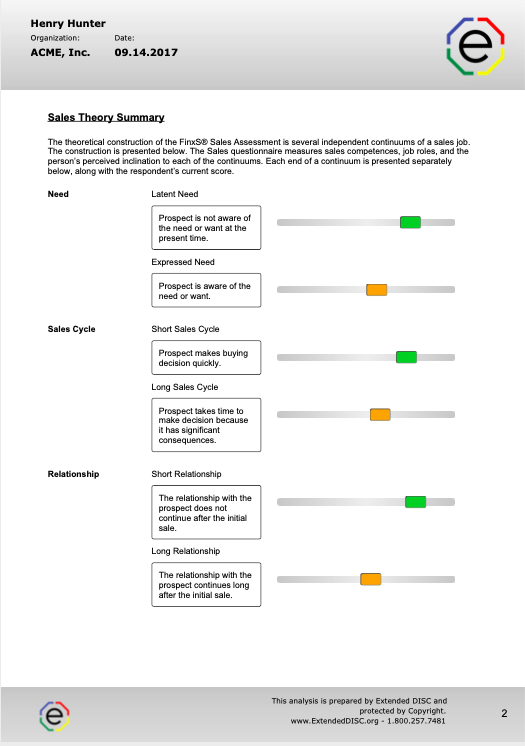Sales theory breaks down the continuum of a sales job. So, how does that help you?

Wouldn’t it be great if we had a template for the perfect salesperson? Unfortunately, we all know there is no one ideal salesperson; the best person depends on what you need to accomplish in the role. People who excel at one sales role may need further development in another. For example, you have one salesperson who is tops at finding new clients, but struggles to retain them long term.
The sales theory is a basic model to help you understand the theoretical construction of the sales job using several independent continuums. How can these continuums help you better match your sales people’s’ strengths?
Sales Theory continuums

There are 18 specific sales competences in the Sales Capacity Assessment. A sales person’s competences are identified within three different continuums; how they deal with their prospects’ needs, how they perform within the sales cycle, and how they manage their relationship after they close the deal.
The first continuum is Need. The ends of the Need Continuum are Latent Need and Expressed Need. Latent Need occurs when the prospect is not aware of the need or want at the present time. Expressed Need is when the prospect is aware of the need or want.
The ends of the Sales Cycle Continuum are Short Sales Cycle and Long Sales Cycle. Short Sales Cycle involves a prospect making buying decisions quickly. The Long Sales Cycle occurs when the prospect takes time to make decisions because it has significant consequences.
The ends of the Relationship Continuum are Short Relationship and Long Relationship. Short Relationship identifies when the relationship with the prospect does not continue after the initial sale. Long Relationships continue with the prospect long after the initial sale. We can overlook a lot of business opportunities after the initial sale.
What is the value of the Sales Theory Report?

The FinxS® Sales Theory Report is a part of the FinxS® Sales Capacity Suite of tools, which measures sales competences, job roles, and the person’s perceived inclination to each of the continuums. The one-page Sales Theory report is a way to provide information quickly and concisely. At the same time, the information is complementary to other Sales Capacity Assessment reports if a deeper dive is needed.
The report identifies an individual’s current score on 6 graphs; each representing both ends of the Sales Theory continuum. It can be your best place to start when you are thinking about requirements for different sales skills for different needs and different sales cycles. It’s a quick start using a simple approach.
Coaching Tips
This information can help us to look at our sales people, prospects, and how we can make better decisions in hiring and developing our sales people.
Focus on high scores because that will help you understand the strengths that builds on your success. Often times, we are more focused on our low scores, “what am I not good at?” versus looking at what we do naturally well. Remind your sales people to maximize their strengths and to not take their strengths for granted. However, remember to not overuse them to a point of weakness.
If there is a low score and it is critical to the person’s success in their job role, then use additional information on competence development in other reports such as the Development Report. Contact us to learn more about the Sales Theory report and the Sales Capacity Assessment suite of tools.
